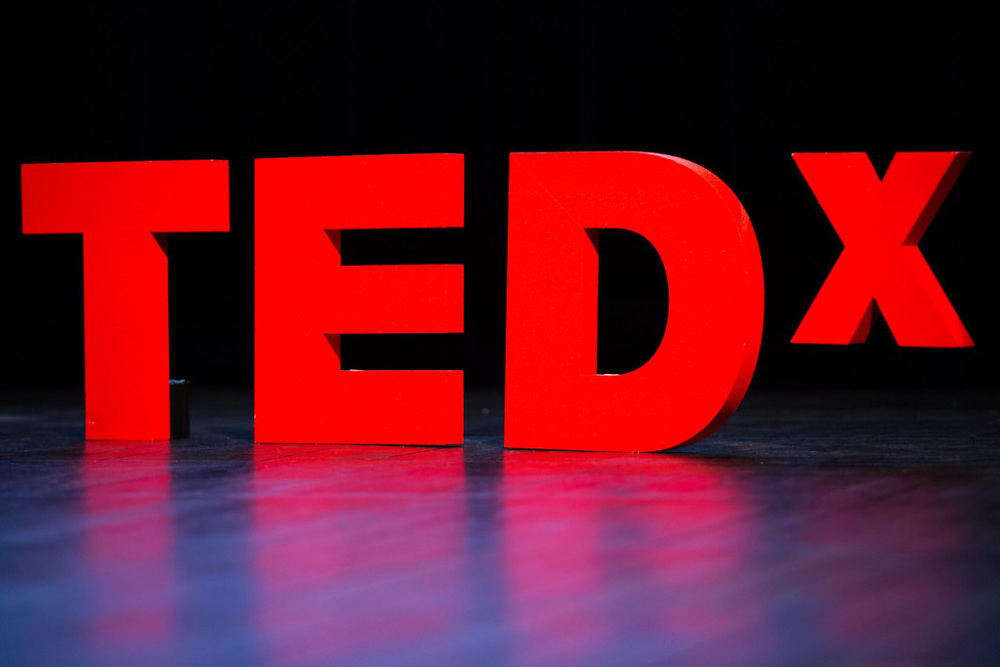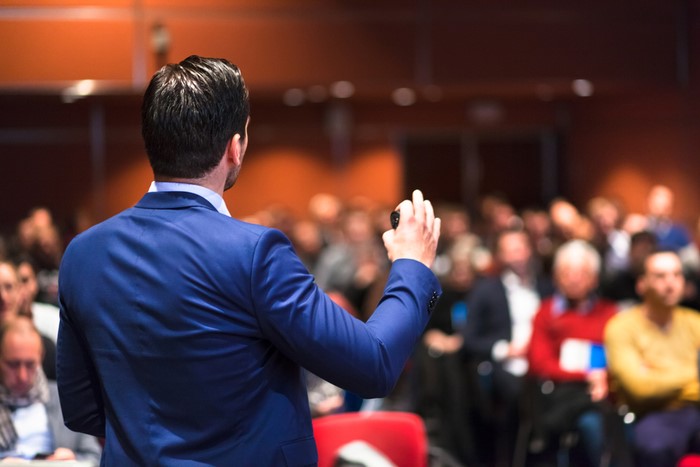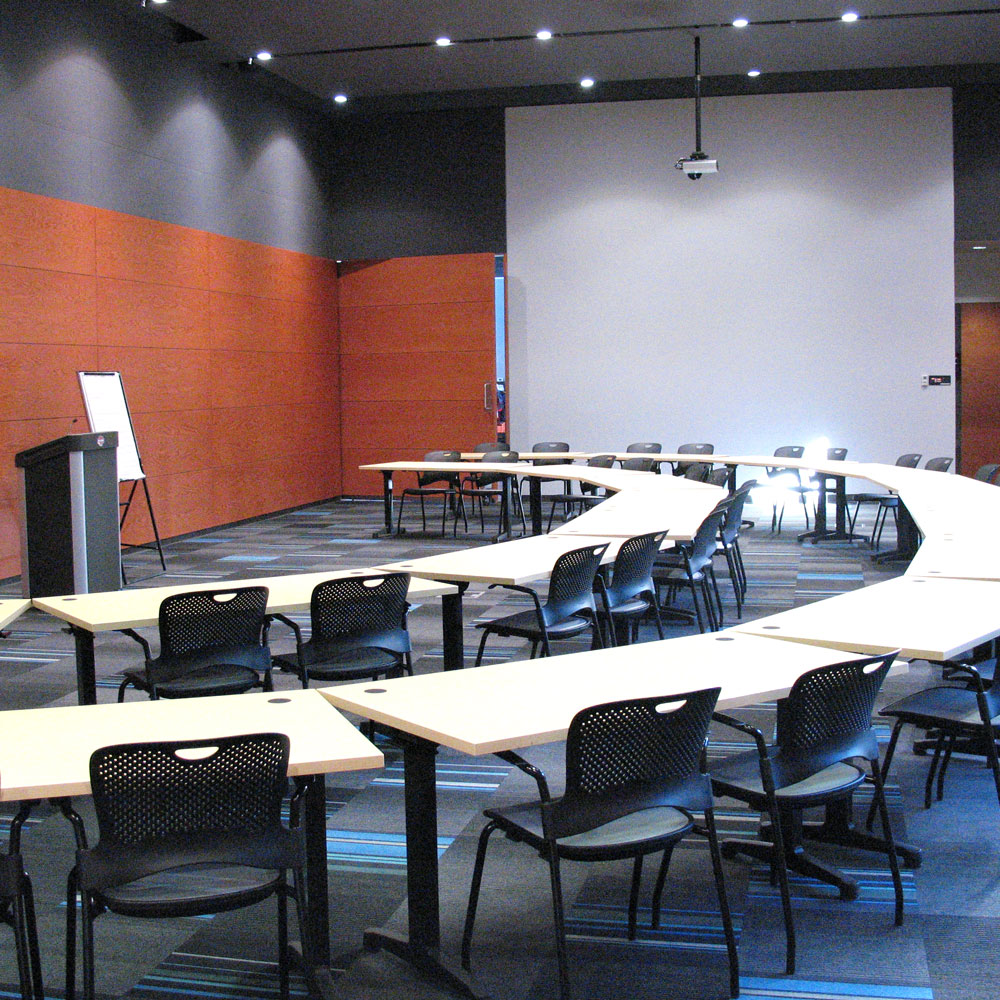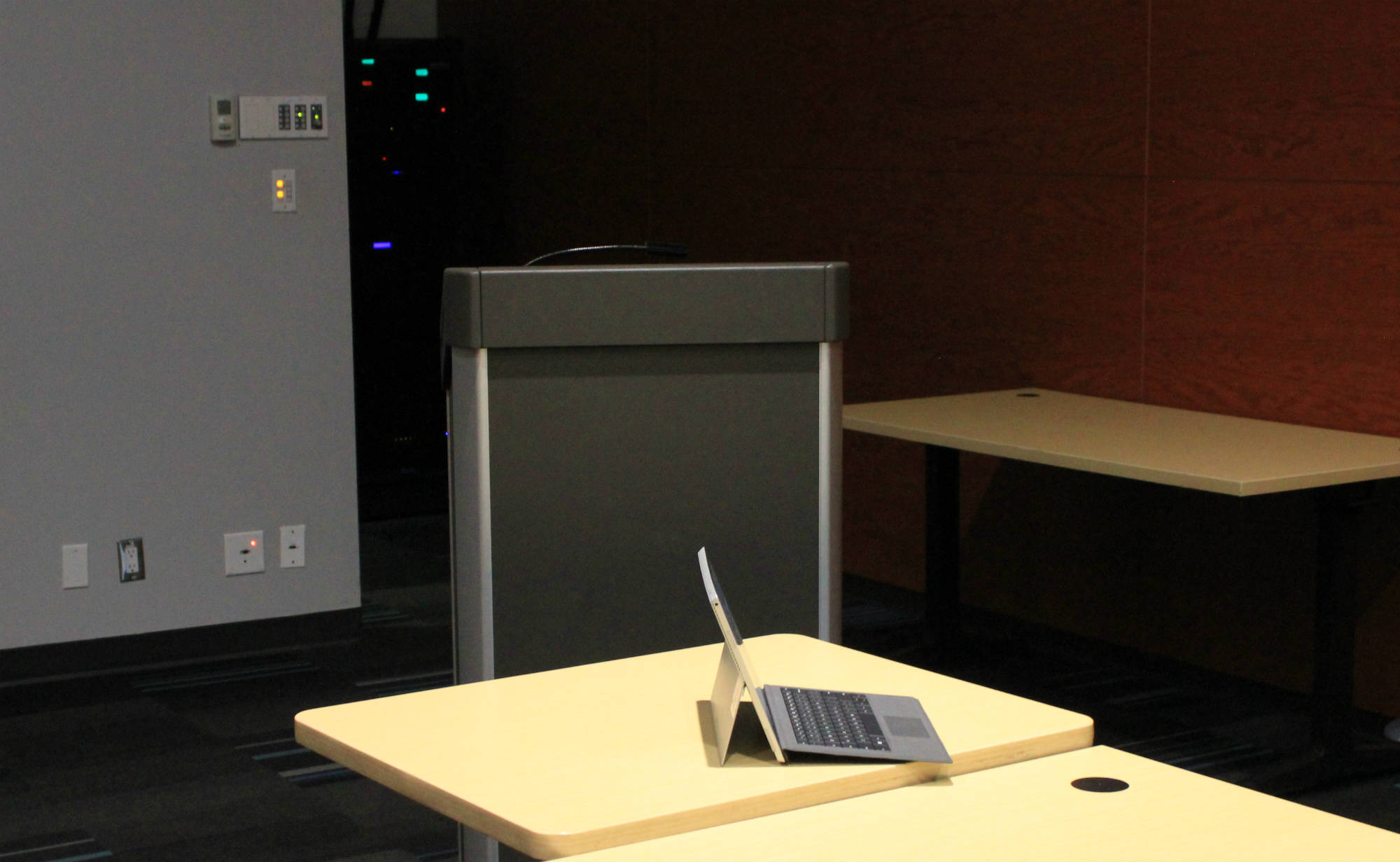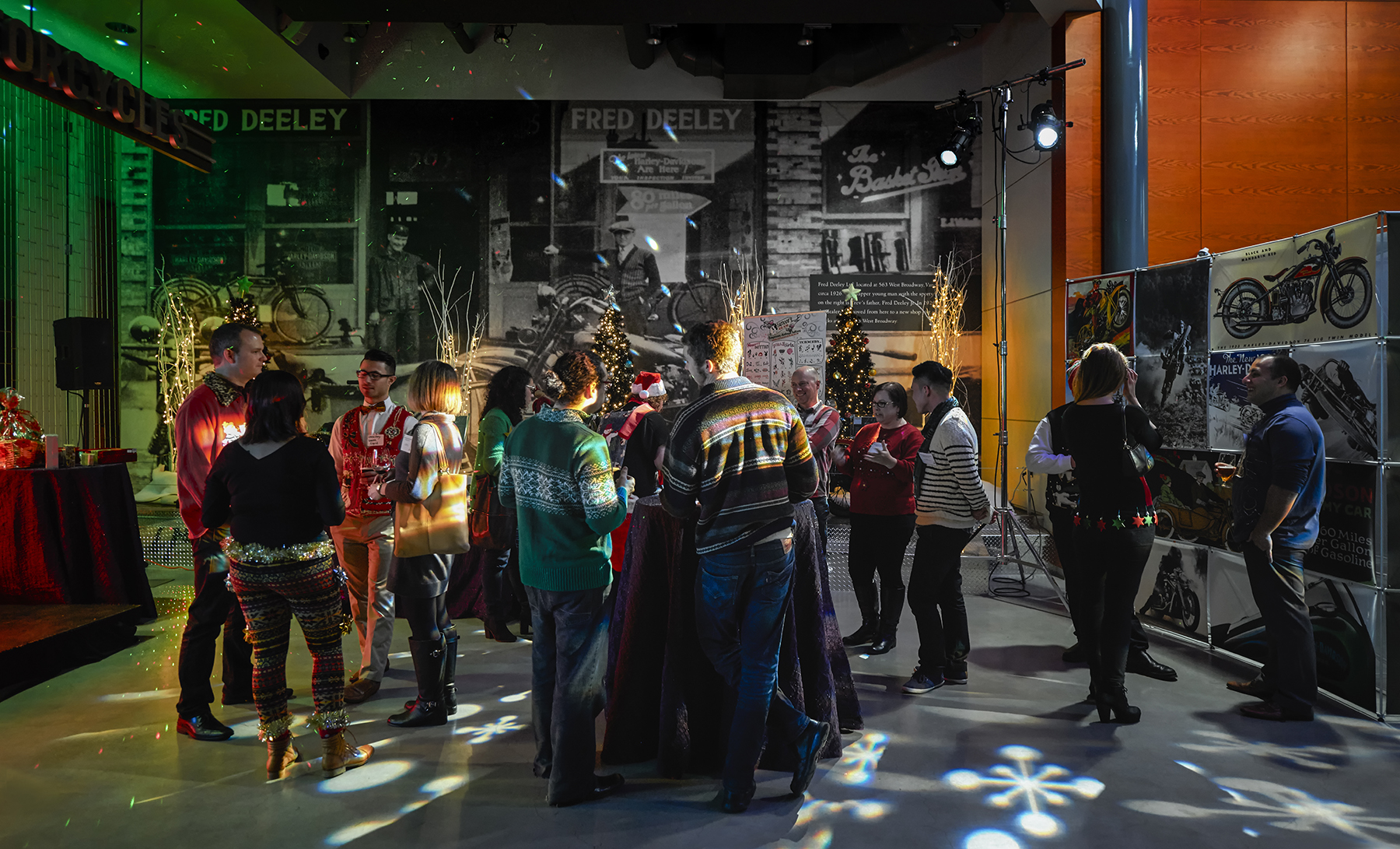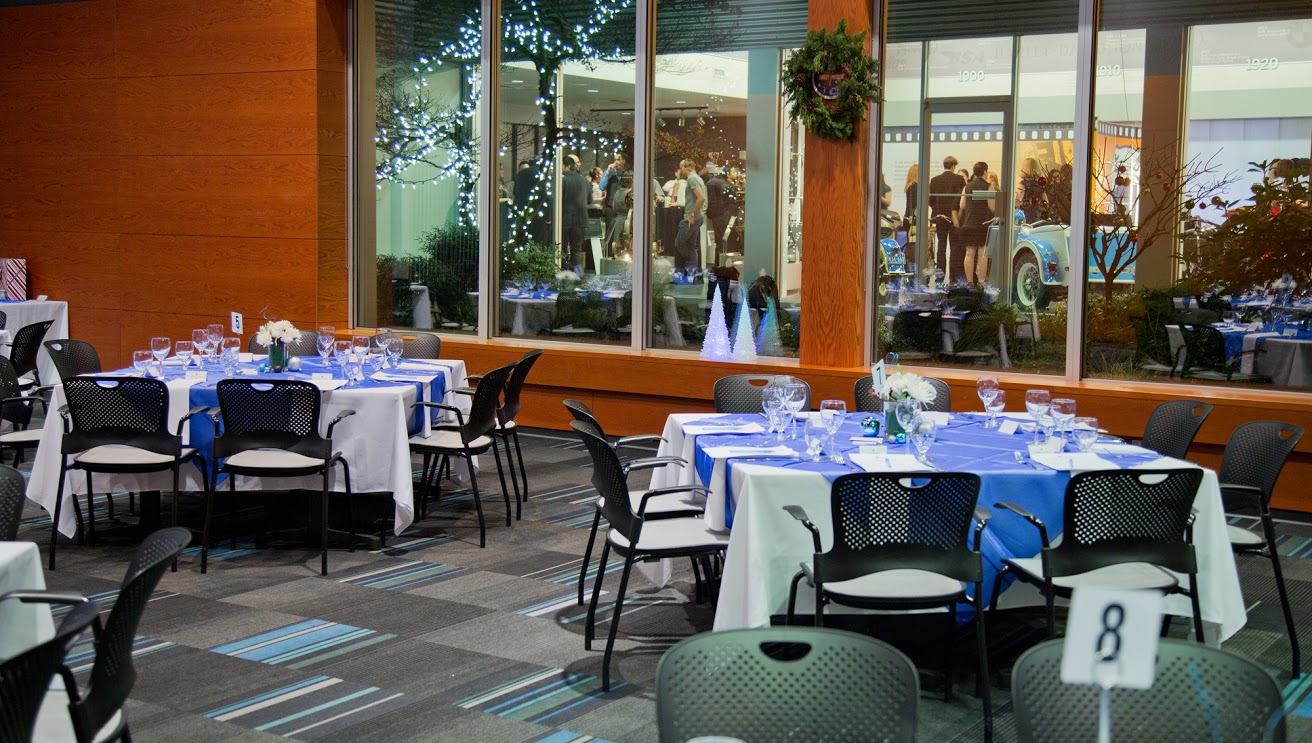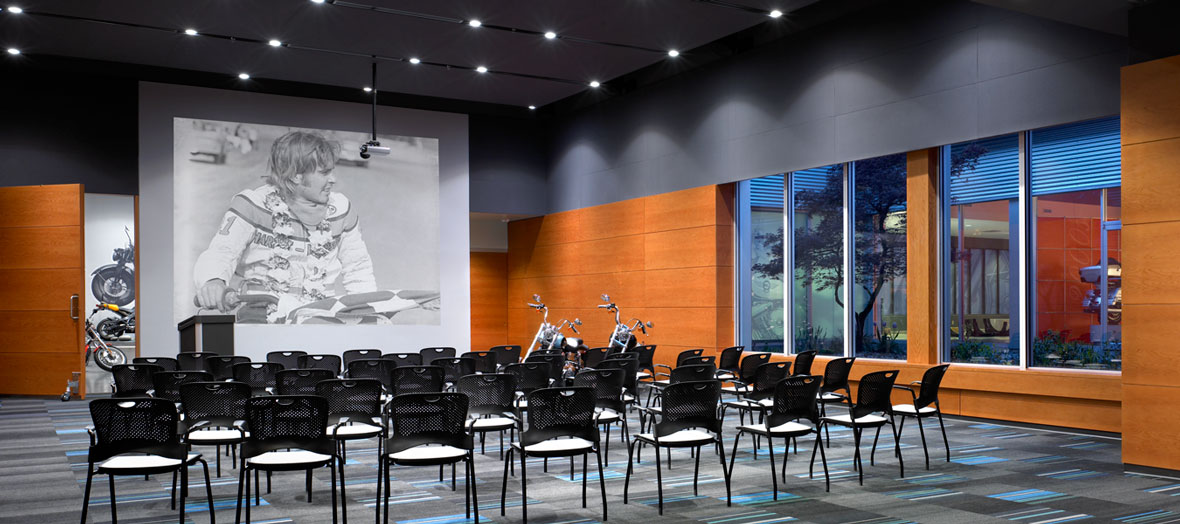A few years ago Jeff Kear wrote a great business management piece about choosing an event venue.
Kear puts forward a lot of great questions that you should answer before choosing a venue – it’s one of the best articles on the topic. We asked ourselves all of the questions you should be asking when searching for the perfect unique venue for your event.
With no further ado, here are the 40 reasons Deeley Exhibition should be your next corporate or meeting venue of choice.
Availability
1. Is there space available on the desired dates and times?
That depends on when you’re looking to book. The sooner you book the better, as most venues start taking bookings well in advance. Leave yourself 2-3 months to book for the dates you want for daytime corporate meetings and at least 6 months for events on weekend evenings or during the Christmas season.
2. Is there a premium or discount for booking during certain times of the year?
Because we’re an independent conference and meeting room facility not attached to a hotel, we’re not subject to the same seasonal extremes of ebb-and-flow as tourism-impacted conference centres. This means we often have dates available when other venues do not.
We offer flexible rates for companies, organizations, and government bodies looking to book their multi-day meetings with us.
Location
3. Will the venue be convenient for guests in regard to travel and accessibility?
The Deeley Exhibition is located on Boundary Road between Burnaby and Vancouver, right off of the Trans-Canada Highway.
We are 25 minutes from the Vancouver International Airport by car, 15 minutes from downtown, 5-10 minutes from several hotels and super-accessible by bus and by Skytrain.
We are also 100% wheelchair accessible.
4. Will it be a destination venue that naturally attracts people?
Trev Deeley was Canada’s first – and exclusive – Harley Davidson distributor.
Since 1917 the family sold the excitement, desire, and wonder of performance motorcycles. Over the last century, Trev put together one of the world’s best and biggest private collections of vintage motorcycles from private owners, famous movies, and war assets. This is where those motorcycles live, and they make an interesting and engaging background for any event, from fundraisers to professional seminars.
5. Is the venue in a local or part of town in which people will feel comfortable?
You bet. We’re on beautiful, tree-lined Boundary Avenue, with the backdrop of the Lions and the North Shore mountains. If you need to stretch your legs to refresh during meetings, we’re just a 5-10 minute walk from Thunderbird, Rupert, Charles, and Adanac Parks.
Price
6. Is there a change in fees between winter and summer?
No. We cater to a wide range of businesses, organizations, and individuals who need conference and meeting room services year-round. However, during the Christmas season, evening weekday corporate party rentals are priced at the same price as weekend evening rentals due to high demand and complexity of the event.
7. Is there a difference between weekday or weekend?
Yes – weekend daytime and evening rentals are priced at a premium due to the types, complexity and length of events that are held. Weekday events are typically priced at a lower rate.
Evening appointments are a premium engagement that require a full venue buy-out; meaning that evening events must book the entire facility – museum, lobby, and meeting room.
8. Is there a deposit required, and is it refundable?
We ask for a non-refundable 50% fee on the cost of the space, and allow organizers to change the date once within 60 days (provided the date is available).
9. Is there a minimum payment required for booking?
The minimum booking we offer is a half-day, 4-hour block in our large meeting room. This is to account for set-up and tear-down, cleanup time, and required coordination and administration.
10. What kind of value-adds does Deeley Exhibition include?
We take care of you from the start, by focusing on your peace of mind. We take care of room setup and tear-down, we help with setup of audio-visual services and projection, and we’ll help you out with floor layouts for tables and seating, specific to your event. Organizers looking for specific items we don’t normally provide are welcome to call for more information.
11. What kind of packages are offered and what do they look like?
Every client and event requires different elements. Our expertise is in catering to completely individual and unique needs, and we facilitate this by making our services entirely à-la-carte for weekday events.
There’s no premium charged on one service while offering you things you won’t need. You’re only charged for what you use.
However, for evening, full venue buyout events, our basic fee also includes a site manager to assist with the execution during your event and excellent in-house A/V amenities typically offered à-la-carte.
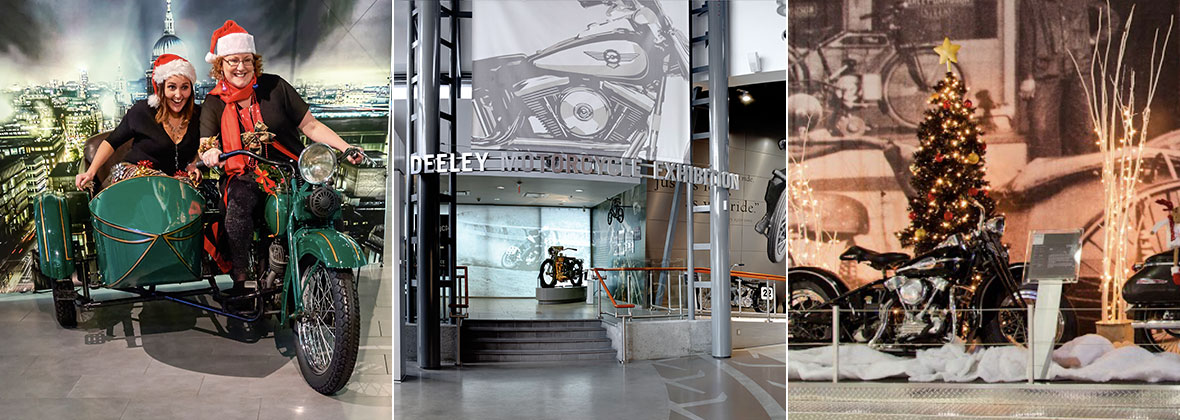
Space
12. Can Deeley Exhibition accommodate my large group?
We can accommodate up to 150 people standing room for a daytime event in the meeting room, or 250 people for an evening event (full-venue booking). Our large meeting room can comfortably host 80-100 peoples with tables, depending on the layout you’re looking for.
13. What are the separate spaces in Deeley Exhibition?
We have our large meeting room, the exhibition museum, and our foyer. Our 1,800 square foot meeting room is large, well-lit by natural light during the day (thanks to our huge windows), and brightly lit during the evening. The room has a partition to convert it into a smaller space of 1,350 square feet or two spaces, depending on the format of your event.
Our grand front foyer and museum exhibition hosts the collection itself and bikes are parked right out where you can walk between them. The collection is carefully curated and beautifully designed.
14. What is the flow of the space?
To get an idea for this space check out our virtual walk-through.
15. I have some large items and staging for my event. Can Deeley Exhibition accommodate?
The safety and security of the collection is our primary concern. Otherwise we’re happy to help you with larger staging and focus pieces, space and requirements depending. Special handling fees will apply.
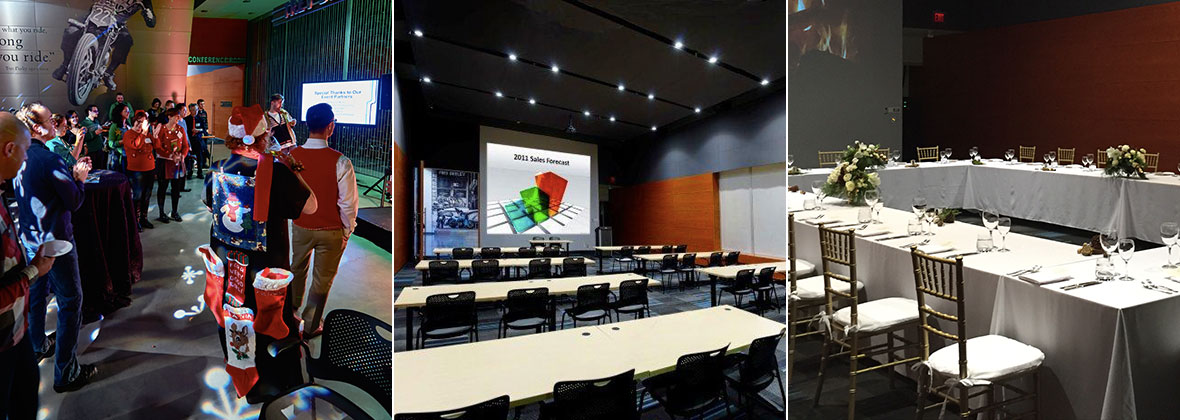
Venue condition and colours
16. Will the condition, colour, and decor of the venue complement my event?
Deeley Exhibition’s meeting room and foyer was redesigned by Stantec Architecture and Engineering with premium finish and polished design in mind. Our space is finished in neutral concrete and burnished woods which accentuate the class and decorum of the bikes’ storied history. Glass, steel, and large black and white historical photos make this a unique venue.
Our museum has changing exhibitions and therefore, changes in appearance from theme to theme. The concepts are developed in-house by our Director, Brent Cooke (a renowned Canadian artist, who most recently received the “Artist of the Year” distinction by the World Wildlife Federation). The design work of each exhibit is developed by EDG – Experiential Design Group.
View more conference facility photos or take a virtual tour.
17. Is there anything that might hamper my guest’s experience?
Only if your music is too loud. We’re wheelchair accessible, and have railings for ramps and stairs in case you need assistance getting around.
Policies
18. What do I need to know about refunds and guarantees?
To secure a date, we require a booking deposit. Depending on the scope and cost of your event, suppliers may ask for deposits and minimums.
If you are planning an evening event, depending on who you want to hire, many caterers ask for 50% up front to secure your date, same as the venue. Caterers may ask for full payment within 2 weeks of the event, as a guarantee. Many rental companies may require a 72 hour cancellation minimum. So if you have to cancel or reschedule, make sure you notify all involved parties to understand what your options are.
If an event needs to be rescheduled, talk to your venue and suppliers right away. It is always possible for dates to be shifted, provided there is adequate time, but the closer it gets to your event date the harder it is to accommodate changes, if at all.
Catering
19. Does Deeley Exhibition have on-site catering?
We have several catering partners, and work with them based on the type of event being catered. We work with the clients to make sure budgets, tastes and events are individually catered to.
20. Does Deeley Exhibition allow outside vendors?
We don’t allow outside caterers for daytime events but we will work with you for catering evening and weekend events. If you bring in an outside caterer, planning fees may apply for time incurred (as required) for additional coordination.
21. How experienced are the catering manager and executive chef?
We work with many popular and well known catering companies – the client budget and vision usually dictate who we use.
22. Are there food and drink minimums?
Although we have accommodated meeting and events of all sizes, all venues and caterers have minimums spends and surcharges may apply. When you call us to inquire about your event, we will ask you about your meeting or event size and advise you what the minimum charges are.
Reputation
23. What do event professionals and local organizers think of Deeley Exhibition?
We have great relationships with event planners and organizations in the area. You can view some of the testimonials on our homepage, near the bottom.
24. Has Deeley Exhibition had any recent issues that would make an event/wedding planner think twice before booking there?
Not at all. We have an excellent track record of hosting class-leading corporate and business events, social fundraisers, and other professional events.
Unfortunately, we do not allow weddings or private events, like birthdays or dry-grads, in our venue. We are not equipped with the rooms necessary to host bridal parties and we do not allow private self-catered parties. Only events with caterers and proper staffing are permitted. This is for the safety of the museum and its precious collection.
Amenities
25. Does Deeley Exhibition allow for event signage or displays?
Free-standing displays are great, and encouraged. If you have signage that needs securing or mounting, please give us a call in advance. For things like banner affixations, setup and removal is the organizer’s responsibility and needs to be cleared on case-by-case basis.
26. Does Deeley Exhibition have a concierge, or information desk?
There is room to set up a table near in the foyer to greet guests when they enter the building if needed. Upon entering the wide open foyer, guests can easily identify which way to go to see the exhibition or to find the meeting room.
27. Is there a business centre for use?
We can assist in providing copies of meeting documents as needed for a nominal fee.
28. Does the Deeley Exhibition and Conference Centre have shipping and receiving services or personnel?
Yes, we can help you with receiving and staging items for your event. Handling charges may apply.
Utilities
29. How are the outlets and lighting in the space?
We’re designed for business meetings, learning conferences, and social events like fundraisers and black-tie galas. We can accommodate all of your needs, but give us enough information and advance notice to get the space optimally setup for your needs.
30. Is there natural light, and a way to shade it?
Yes and yes. In our meeting room and foyer we have big, gorgeous floor-to-ceiling windows. The meeting room is equipped with blackout shades so you can bask in the daylight or shut it out for projections.
31. How reliably can Deeley Exhibition create a comfortable environment?
Part of having a big engineering firm like Stantec handle our redesign is that the HVAC system is solid as stone. Making sure our guests stay comfortable and the collection stays safe – and in premium condition – depends on it.
AV and Acoustics
32. What kind of PA and music amplification is there?
We have a fully-integrated, rack-mounted and secured audio-visual setup. Recently upgraded, it’s professional-grade, and can support some plugin or pass-through to other systems. We have up to 4 microphones and separate sound can be piped into the foyer and meeting room areas.
We will assist with setup onsite as needed, though extra fees may apply depending on the amount of help you need. If you’re hosting something as important as a TEDx talk or a sessional lecture, you’ll probably want to have your own sound engineer on retainer.
33. What are the acoustics like?
Like most venues, the number of bodies and the type of engagement have a big impact on sound.
The meeting room is designed for exactly that; meetings, conferences, talks, and conversational engagement. There are acoustic panels on the ceiling to retain sound and speakers around the perimeter of the conference room ceiling. Depending on your voice and timbre, and the number of bodies in the room, you may not even need a microphone.
The foyer and museum have great acoustics for larger, live, un-amplified musicians (such as a baby grand piano). Smaller instruments may need a helping hand from a small amplifier or studio monitor.
If you’re hosting a black-tie gala, or a corporate Christmas Party, your needs will differ. We’ll work with you to help make sure you have the best experience possible.
34. Who are Deeley Exhibition’s preferred vendors for AV and music?
We prefer to work with Promax Audio Visual. They’re fantastically knowledgeable, professional, and easy to work with. If you are looking for music, we can provide you with the names of local DJs that are excellent.
Weather
35. Are there any seasonal weather issues associated with Deeley Exhibition?
Gorgeous mountain vistas, warm Pacific winds, lush temperate rainforests… Vancouver is one of the most beautiful cities in the world, and ranks in the top three most livable cities in the world year-after-year. Even in the sunny heat of summer, it’s still Vancouver. Bring an umbrella.
If you’re here between October and April, it’s likely to be raining. In 2015 Greater Vancouver received 12.2 meters of precipitation. (For Americans, that’s 40 feet of rainfall over the year.)
Security
36. What kind of security personnel are required?
It depends on the number of attendees and the nature of the event being booked. Public events require additional security, which can be coordinated at the booker’s expense.
Before we accept any booking, we thoroughly ask questions to understand your event, especially to determine whether there are any security issues. If an event may put our valuable motorcycle collection at risk, we cannot accommodate hosting the event.
Privacy
37. Is there the ability to shield the event from public view?
Yes. The spacious meeting room is centrally situated but entirely private, allowing for confidential discussions or enhancing private corporate engagements. When the large main door is open, the meeting room becomes an extension of the main foyer space, and can be used for food service and/or seating to compliment the foyer’s natural social interaction.
Parking/Transportation
38. Is there ample parking available for hosts, guests, and attendees?
Yes, we have both front and rear parking lots to accommodate event participants, including street parking. Best of all, it’s free!
39. If guests are arriving from out of town, is there convenient transportation to get to the venue?
Absolutely. We are centrally located between two major transit interchanges, just off Highway 1, and there are several hotels within a 5-10 minute drive.
Restrictions
40. Are there any special restrictions that Deeley Exhibition has when renting the space?
To safeguard the safety and integrity of our collection we do not cater to personal events such as weddings, birthdays, dry grads, or anniversaries. Our ever-present and stunning collection is our centrepiece, and we need to guarantee that guests and attendees come, and leave, with great respect for the bikes.
We hope these questions helped you get a better understanding of the many things Deeley Exhibition has to offer as a unique venue for your cocktail party, business meeting, corporate retreat, or other major event.
